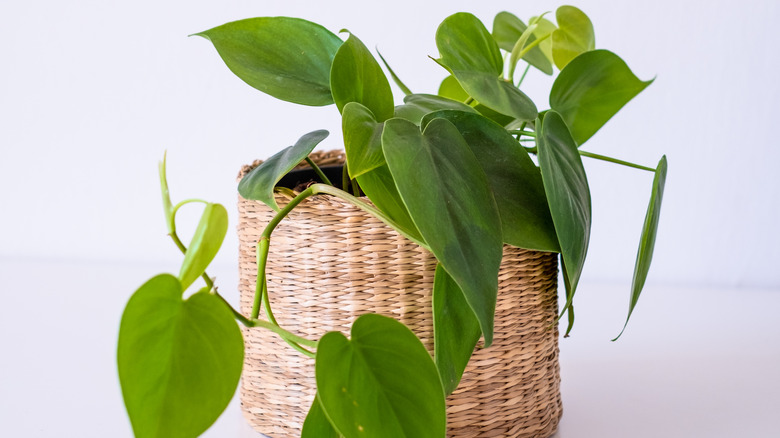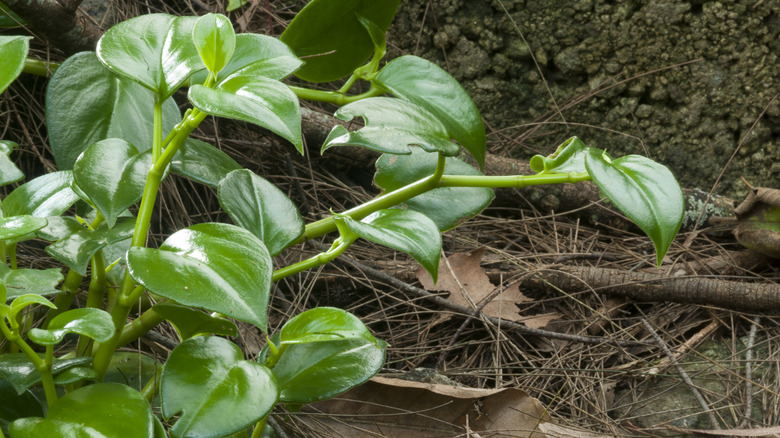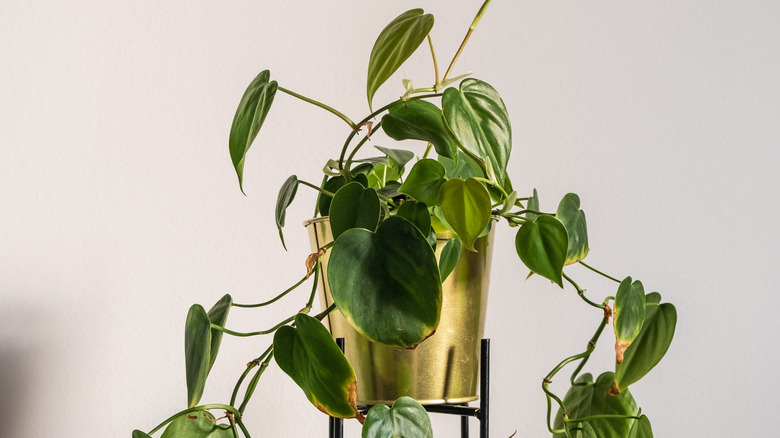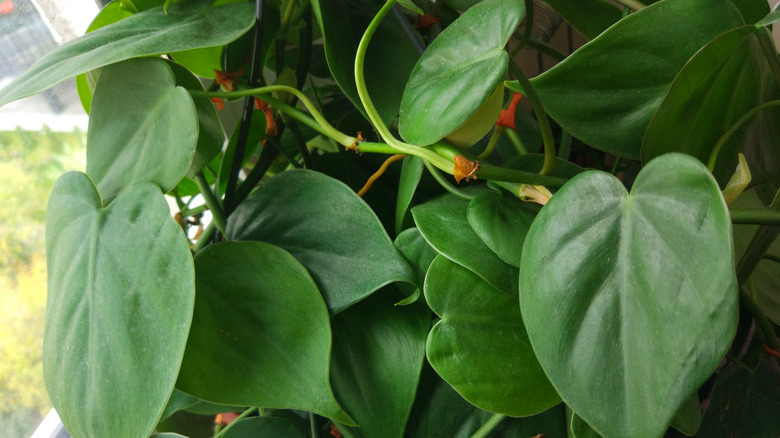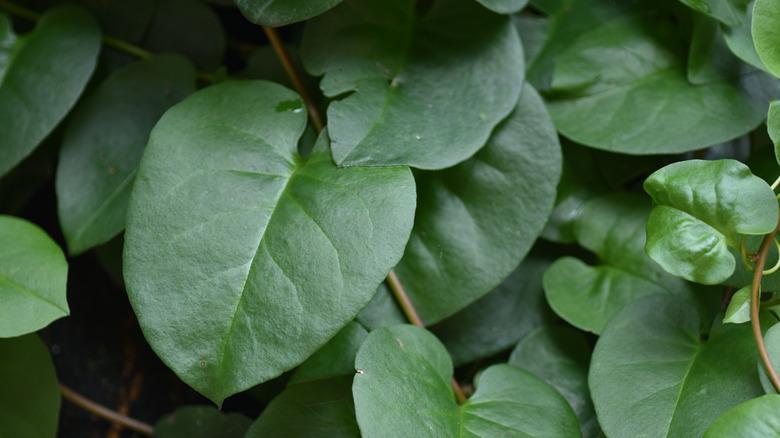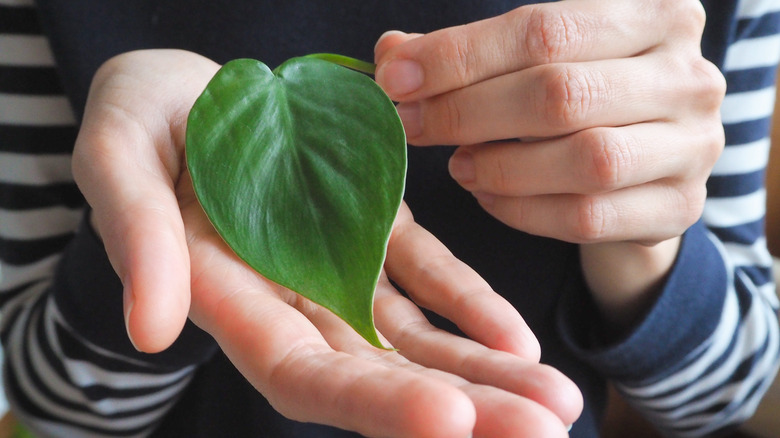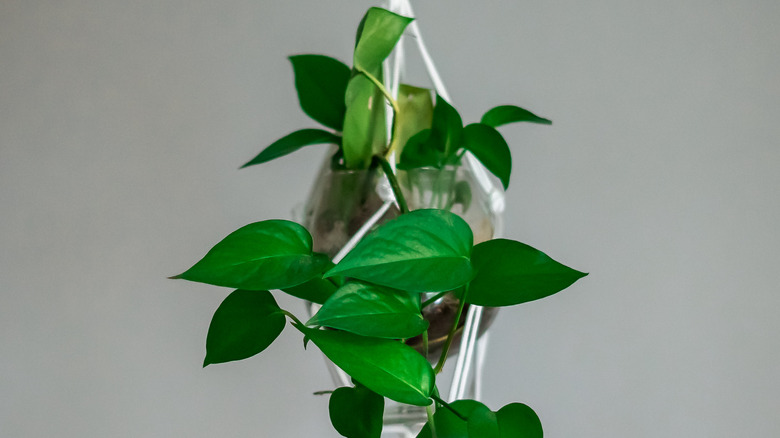Heartleaf Philodendron: Everything You Should Know Before Planting
The heartleaf philodendron, also known as philodendron scandens or the sweetheart plant, is incredibly easy to care for while still being an eye-catching addition to your space. Distinguished by its heart shaped leaves, the heartleaf philodendron is perfect for someone looking for a low-maintenance, yet gorgeous, houseplant.
This plant has its origins in Mexico, Brazil, and the West Indies, and as such is classified as a tropical plant (via The Spruce). It has a natural tendency to climb and trail, making it an ideal hanging plant. Given the right conditions, these plants can grow up to 3 feet or more, according to House Plants Expert.
The heartleaf philodendron does not just stun with its unique shape and beautiful trailing abilities. It is also identified by its remarkably dark green leaves. It also has the ability to produce small white flower spathes, though it is rare. The low effort nature of this plant, coupled with its stunning and unique visuals, make this the perfect addition to any home.
How to use heartleaf philodendron in garden
The heartleaf philodendron can be grown outside, but only under certain conditions. In zones 10B through 11, such as Southern California or Southern Florida, it can be used as ground cover or grown against trees or trellises, per the University of Florida. Since these plants are native to tropical rainforests, it is best to plant your philodendron in the shade, or at least away from direct sunlight (via Gardening Know How). The soil should be kept moist, well drained, and fed about once every season. The heartleaf philodendron is also toxic to humans and animals, so keep this in mind when planting it outdoors.
The heartleaf philodendron does not like to be below 60 degrees, indoors or out, so make sure that wherever you plant it, it will not dip below that minimum. It is not uncommon to bring philodendrons outdoors for the summer in cooler zones, but just be wary of temperatures falling below 60 degrees at night, and make sure to bring them back inside if it gets consistently too cold. This plant makes for a really unique ground cover when it can grow in the right conditions. If you live in a warmer climate, it will make for a stunning addition to your landscape.
How to grow heartleaf philodendron
Growing a heartleaf philodendron is an easy enough task. The simplest and quickest way to grow this plant would be to pop on over to your local plant nursery and buy one. However, propagating a heartleaf philodendron is almost just as simple and easy.
Propagations can be obtained in a number of ways. There are several online retailers that sell propagations, though this option is usually best for rare plants. The most common way is to clip one from an already existing, full-grown plant. Ask a friend for a cutting or snip one from your own plant. Some garden centers may even give away their plant scraps that you can take home and propagate.
To get a cutting, take a pair of clean shears or scissors and cut 1/4 inch below a node on a leafy vine, suggests Sprouts & Stems. The node is the bump found at the growth site for a new leaf. Put the cutting in a clean jar or glass, and fill it up with room temperature water. If you'd like to speed along the growth, add a pump or two of liquid fertilizer. Place the propagation in a sunny area, and after a few weeks the cutting should develop roots about 2 inches long, changing the water once a week. Plant the propagated stem in soil and care for it just as you would a full grown plant.
How to care for heartleaf philodendron
As stated earlier, the heartleaf philodendron is incredibly easy to care for, making it a great beginner plant, and is suitable for a variety of indoor spaces. This plant will do well in most lighting, but does best in bright, indirect light. While it can survive in shade, excessive amounts of direct sunlight can burn the leaves of heartleaf philodendron, as noted by The Spruce. North and East facing windows are ideal for this plant, while South and West facing window dwellers may want to shade their plant from the sun's direct rays.
As for water, this plant can survive a little neglect. It is best to water your heartleaf philodendron when it is halfway dry. A good rule of thumb is to touch around the top inch or so of soil with your fingers. If it's dry and crumbly, your plant could use some water. According to Apartment Therapy, your philodendron will appear yellow if overwatered, and brown if underwatered.
Heartleaf philodendrons do not need fertilizer to grow and survive, but adding a little will certainly aid in the process. House Plant Experts suggests fertilizing it with basic plant food every month in the spring and summer, and every few months in the winter. They also suggest misting the leaves in the summer to increase humidity, though it will survive dryer conditions. It is also suggested to trim your plant when it starts to get a little leggy to encourage lush new growth.
Heartleaf philodendron varieties
The heartleaf philodendron is a part of the philodendron genus, which has around 450 varieties, according to Smart Garden Guide. With all species native to South America, they are remarkably similar in terms of care, and offer a stunning visual variety to spruce up your space.
Here is a list of some of the most interesting varieties:
-
Philodendron Hastatum — This stunning, silvery variety is one of the most in-demand philodendrons — so much so that even though it's endangered in Brazil, it is not in danger of extinction due to its popularity!
-
Philodendron "Majesty" — With its dark, purple-ish matte leaves, this pricier variety is highly sought after.
-
Philodendron "Pink Princess" — Similar in shape to the heartleaf philodendron, this variety is distinguished by its pink accents, as well as its fussier nature.
-
Philodendron "Lemon Lime" — A common but beautiful variety, it is easily identified by its bright yellow-green leaves.
-
Philodendron Brandtianum — This variety sports silver detailing in the center of each leaf (similar visually to the Hastatum without the high price point) and maintains its variegation in low light environments.
Is heartleaf philodendron toxic?
Despite its beauty and innocent nickname, the sweetheart plant is toxic to both humans and animals. Heartleaf philodendron belongs to a group of toxic plants called insoluble calcium oxalate plants, and should never be ingested. The plant produces a sap that can irritate the skin (via Apartment Therapy), so avoid touching this when pruning your plant, and wash your hands immediately after touching the leaves. Make sure to keep heartleaf philodendron out of reach of pets and small children, or avoid keeping it in your home if that's not possible.
When ingested by humans and animals, specifically cats, dogs, and horses, heartleaf philodendron can cause swelling of the ingestion site, irritation, burning, and more. If you suspect your pet has eaten part of your heartleaf philodendron, the ASPCA says to look for: "oral irritation, pain and swelling of mouth, tongue and lips, excessive drooling, vomiting (not horses), [and] difficulty swallowing." If your pet is displaying these symptoms, contact your vet immediately.
How to repot heartleaf philodendron
It is suggested that you repot your heartleaf philodendron once every two to three years in the spring and summer months, as noted by Guide to Houseplants. Repotting your plant will help avoid it becoming root bound, or developing root rot.
To begin repotting your plant, make sure you find a pot with a drainage hole at least 1 or 2 inches larger than its current pot. Water your heartleaf philodendron the day before you want to repot. When you are ready to repot, slide the plant out of its current pot. If it's still in the plastic nursery pot, gently squeeze the sides to encourage it to slide out. Loosen and break up the roots with your fingers, and try to remove as much of the old soil as possible. Remove any rotten roots, too. Add an inch or so of good quality, well-draining soil to your new pot, and then add your heartleaf philodendron. Fill the pot almost to the top with new soil. Consider mixing in a peat-moss based potting mix as well. Finally, water your plant. Consider adding a moss pole or trellis to your pot during repotting to encourage your heartleaf philodendron to climb, suggests The Spruce.
